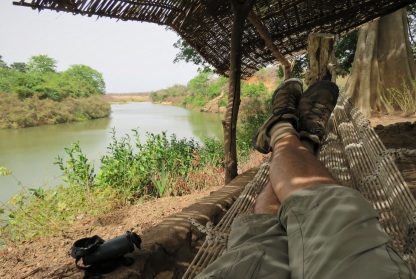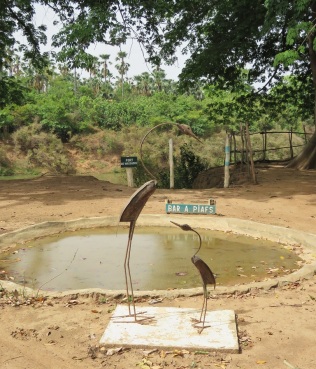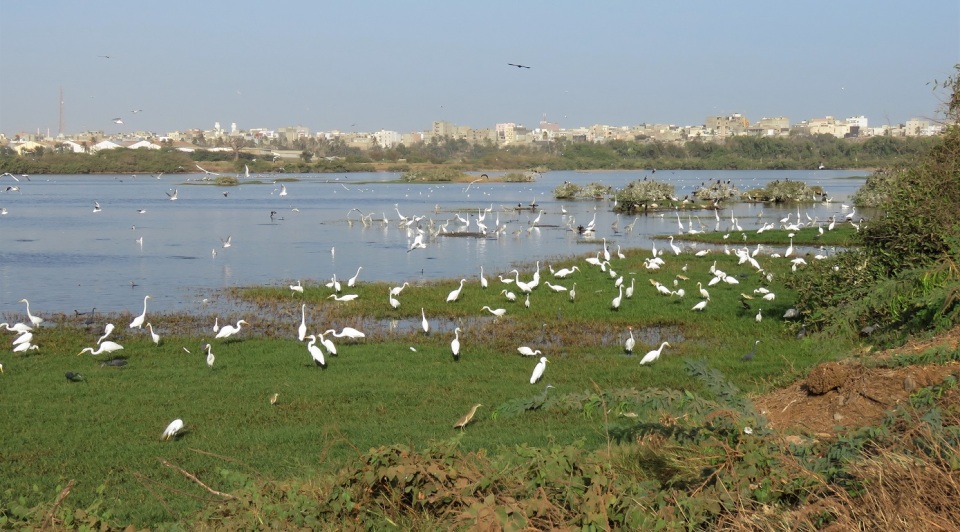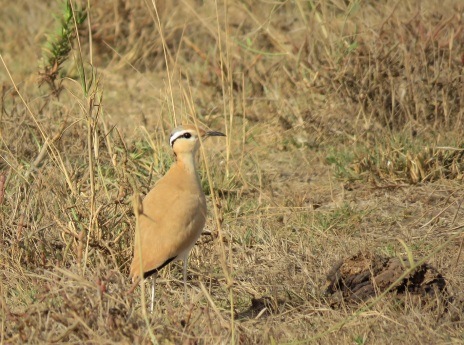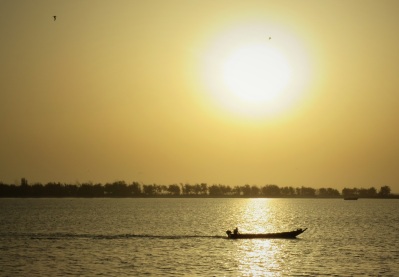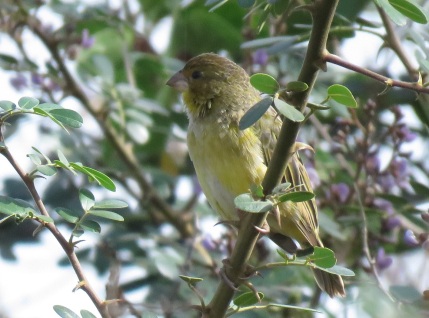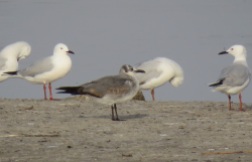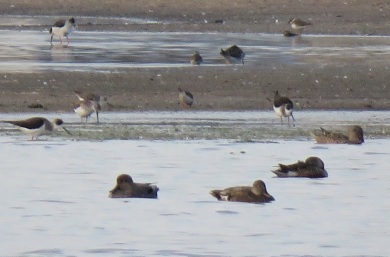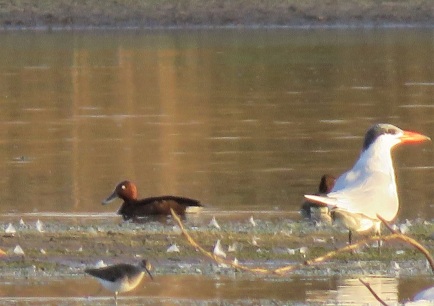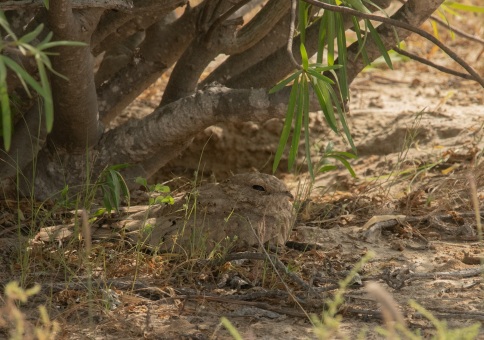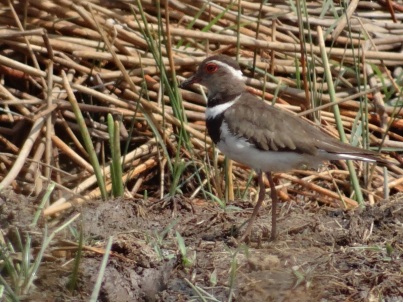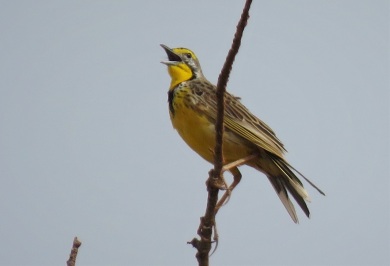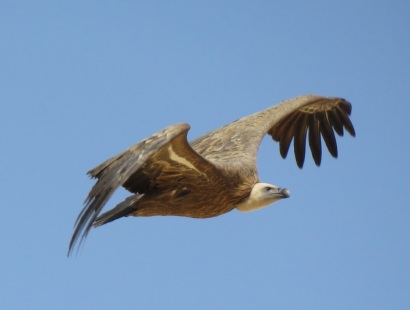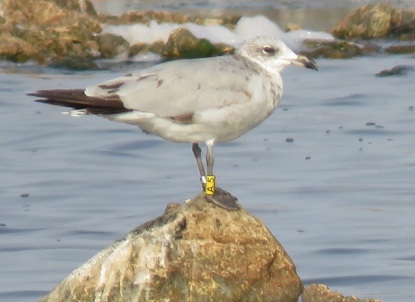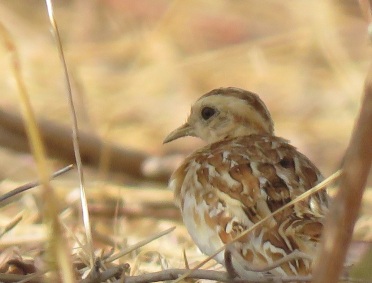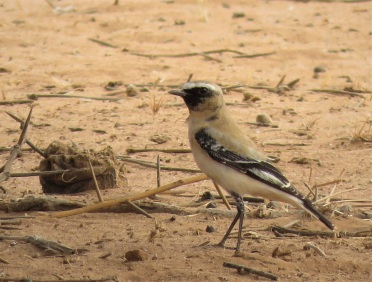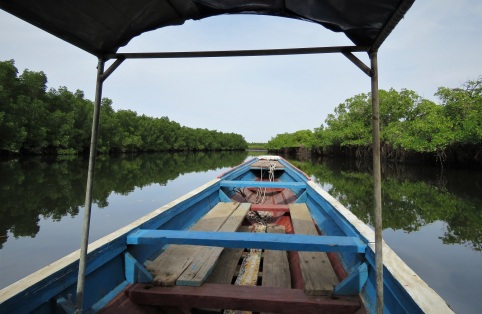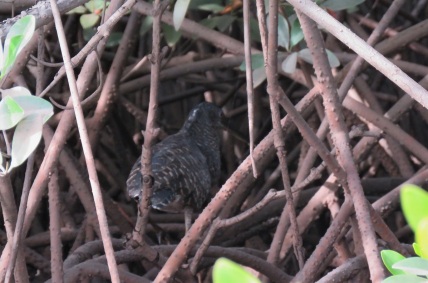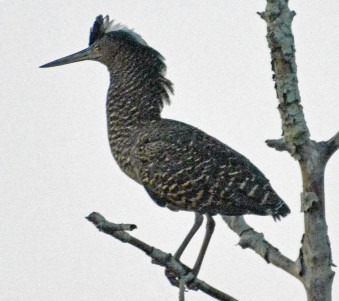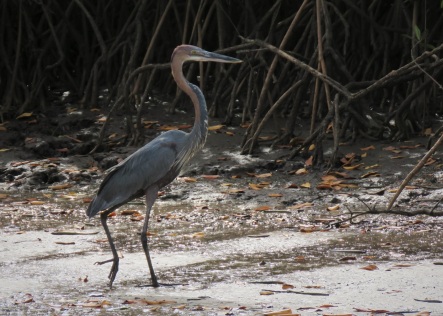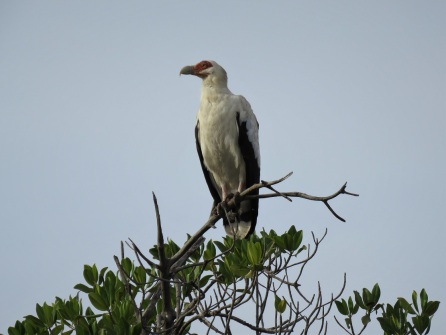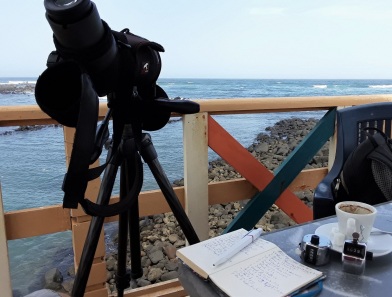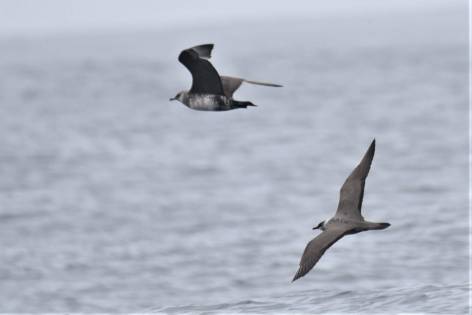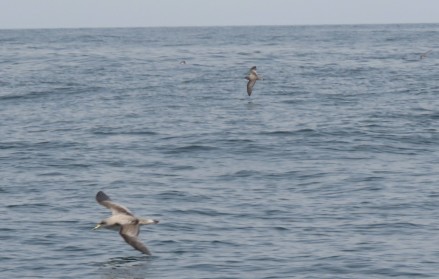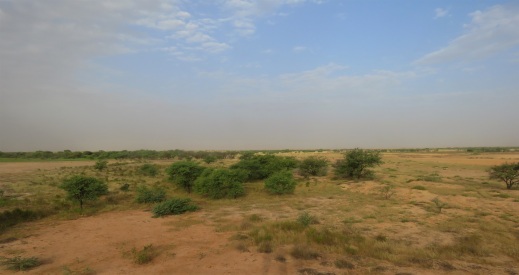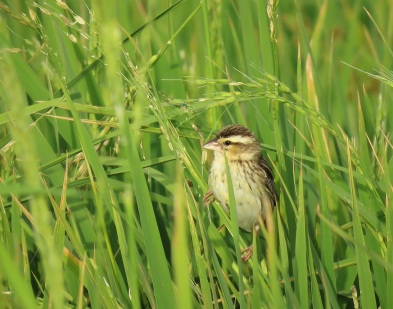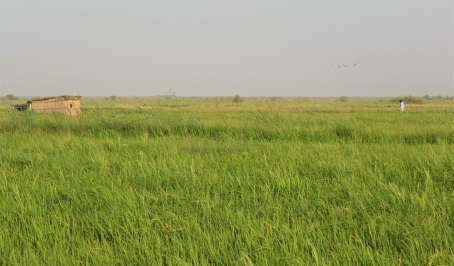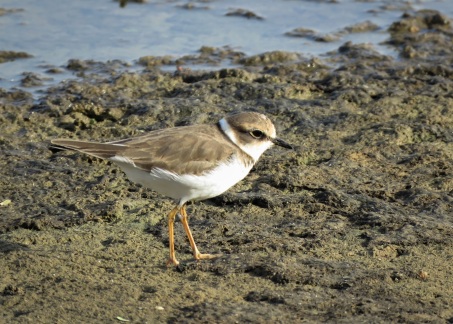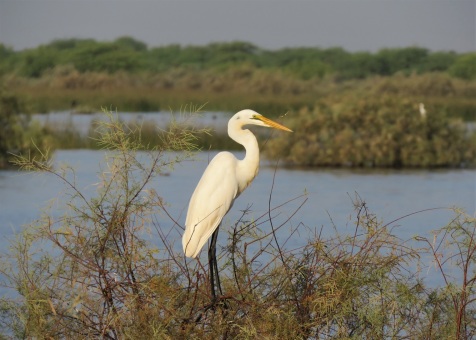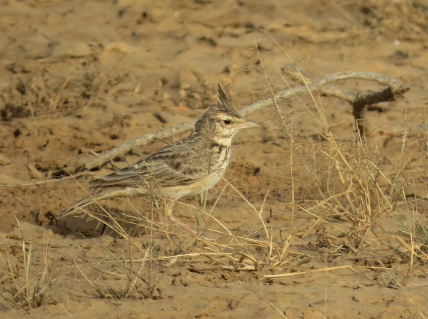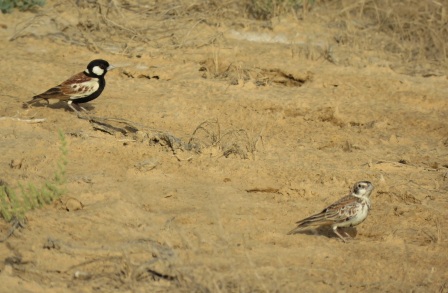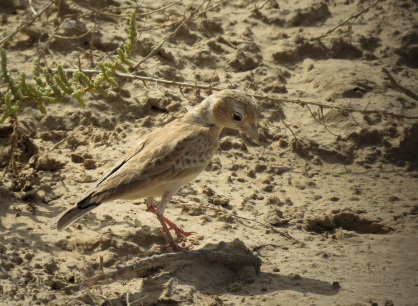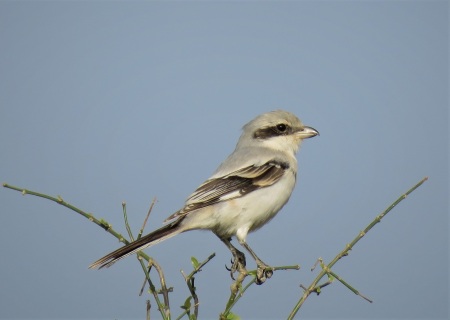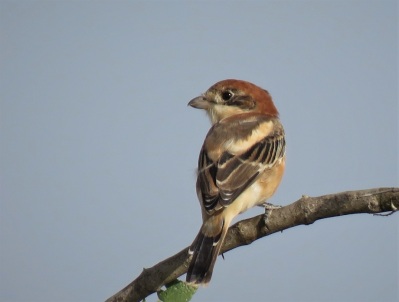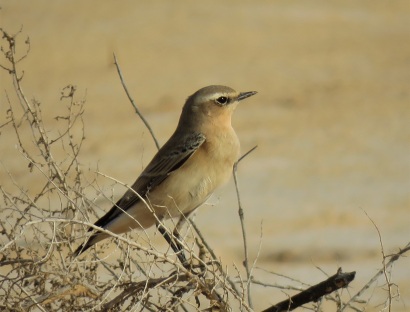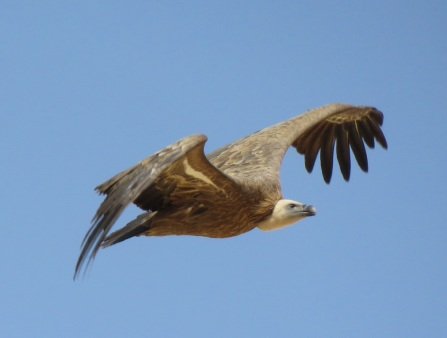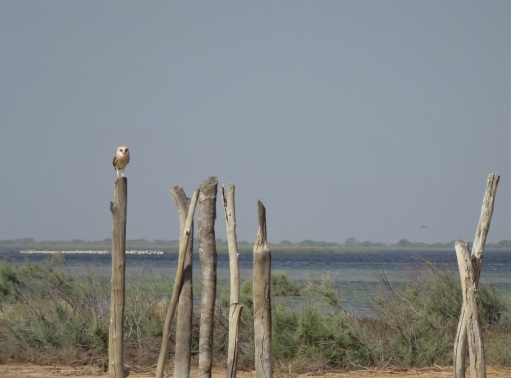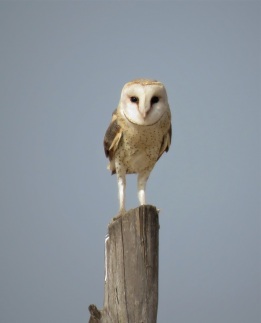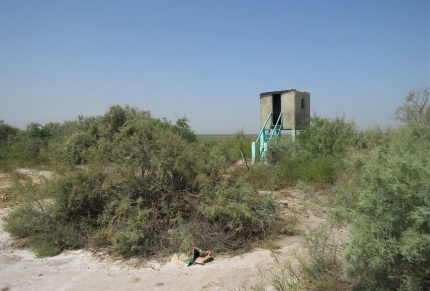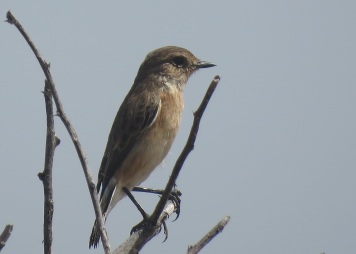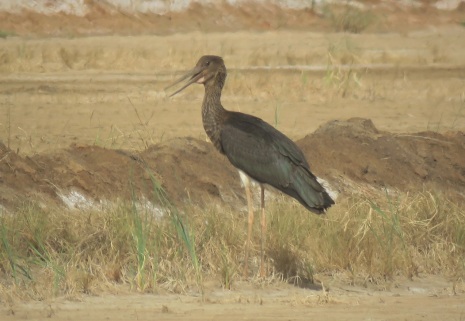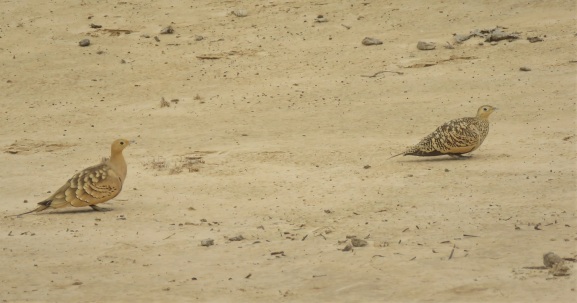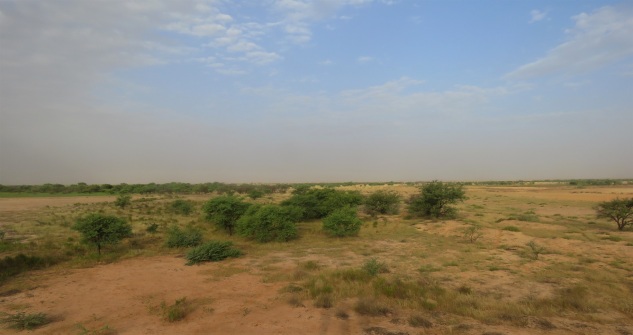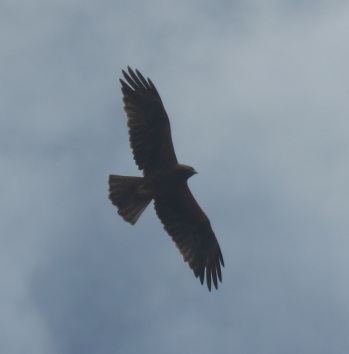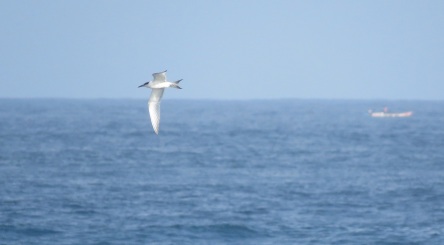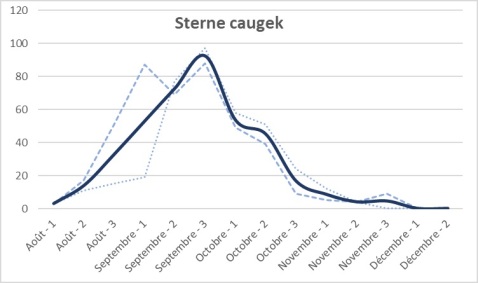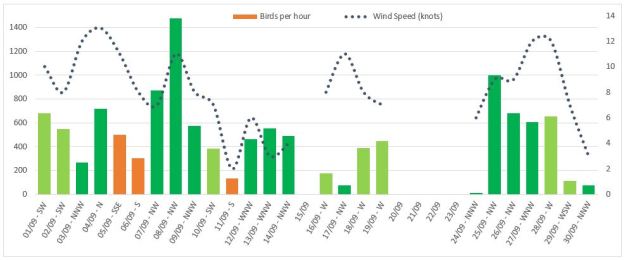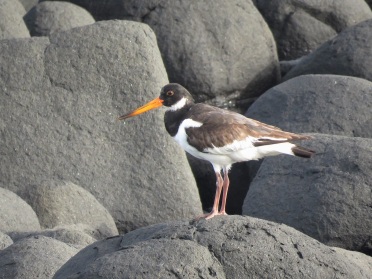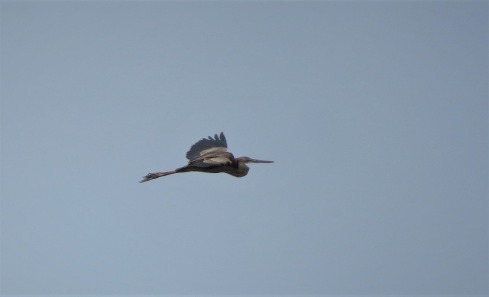Au revoir la Teranga
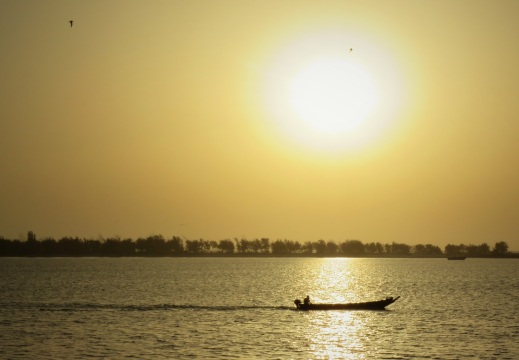
Our regular readers will have noticed that it’s been very quiet on this blog in recent months, so it’s about time I published an update here. There’s a simple reason for the lack of recent posts: after just over five years in Dakar, it was time to move on. Three weeks ago we landed in Laos where we will be based for the foreseeable future, marking the start of a new adventure here in Vientiane. And the end of a pretty amazing experience living in Senegal.
Moving on is of course bittersweet, as I will certainly miss the fabulous bird life that Senegal has to offer, yet at the same time I’m excited to discover the birds and culture of Laos. Even if we’re currently living in rather unsettling and unpredictable times, to say the least. Many of you will be reading this while confined at home, but being extremely busy with my work here I’ll need to keep it short… somehow writing this post is actually the one that I’ve struggled the most with so far – it’s been sitting in my drafts for about three weeks now.
Over the past five years I managed to visit all but one of the country’s regions – sadly I never made it to Matam! – and was lucky to see a good deal of its birds, 530 species to be precise, 527 of which I saw during 2015-2020. A few other numbers: some 52,500 records “collected”, four additions to the country list, about 1,040 sound recordings posted on xeno-canto, tons of poor quality bird photographs, countless happy hours in the field…
There are of course a few specials that I didn’t get to track down, such as Golden and Egyptian Nightjar, White-throated Francolin or Denham’s Bustard to name but a few, and I somehow managed to never visit Kousmar (pretty unbelievable right?) and the Niokolo-Kobo proper (I was happy enough exploring Wassadou on three occasions), but these are all good reasons to one day come back of course. That said, I’m not very optimistic about the state and future of Senegal’s environment, and while this is not the time to expand on this, there have been many frustrating, sad and upsetting moments when confronted on an almost daily basis with the ongoing destruction of natural habitats, with the ever-increasing pollution levels, and with the population’s general indifference and ignorance when it comes to nature and wildlife conservation.
Senegal certainly has treated us well and I feel privileged to have had the chance to explore the country these past few years. I tried to promote birding in Senegal and think I made some modest contributions to the “body of ornithological knowledge” both through this blog (149 posts!) and through a number of papers, 14 to be precise, something we’ll try to continue doing in coming months (years?). The absence of recent posts on SenegalWildlife is definitely not for a lack of ideas or material… just need to find the time to write up stuff, be it here in these pages or elsewhere.
Lots of good memories, of encounters with birds of course but also of places and people, too many to start listing here. Unexpected finds, and some unexpected birding settings.
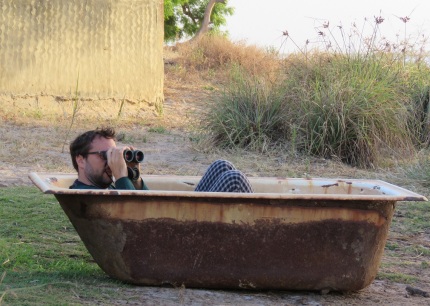
Birding the Saloum delta (yes that’s me in my pyjamas in a bath tub on the edge of a mud flat, one of those randomly surreal settings one may find oneself in… only in Senegal!) – Picture by Jane Piot
Despite the crazy busy few weeks leading up to our departure from Dakar, I was of course keen to go back out to some of my favourite spots: Popenguine, Technopole, Mbeubeusse, Lac Rose, and of course Le Calao for my daily dose of seawatching.
And as always there were some good birds to be seen here, some of which were quite unexpected. During my last visit at Technopole on the morning of our departure (8.3), a pair of Eurasian Teals was a nice find. My final ring reading here was of a French Eurasian Spoonbill ringed in the Camargue colony in 2016… with now +600 ring readings in my little database, there’s definitely enough material to write up another post on this topic. An immature Brown Booby on 21.2 and 5.3 at Ngor was pretty classic at this time of the year. Much less expected was a fine Cream-coloured Courser on the steppe near lac Rose on 20.2, apparently the first record for the Dakar region. It was loosely associating with a few Temminck’s Coursers, a classic species here, just like the handful of Greater Short-toed Larks that were present the same day. A few days earlier, a Temminck’s Stint at Mbeubeusse (16.2) was yet another scarce migrant to show up at this prime location for waders. And during our last visit to Popenguine (23.2) a Chestnut-crowned Sparrow-Weaver was a good record from this location, of a species that is rarely reported away from the south-east and that in fact I’d only seen once before in Senegal, near Kedougou.
Thanks to our followers and regular readers.
Take care, stay safe, flatten that curve.
Au revoir le pays de la Teranga, à la prochaine!
Year in review: 2019
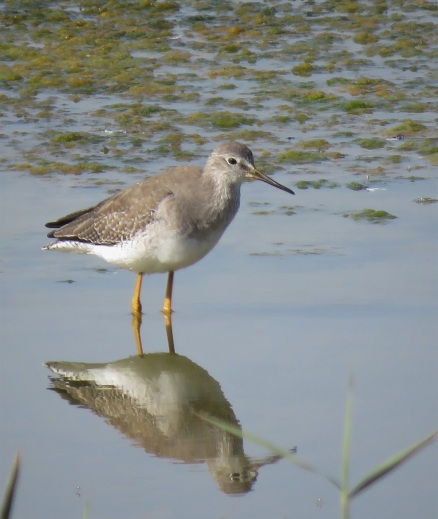
As is now a bit of a tradition on these pages, I’m again compiling a review of last year’s main birding events. Senegal’s bird year 2019 was a pretty good one, with the usual decent mix of new discoveries, rare vagrants, scarce migrants, range extensions and new breeding records.
First things first: last year saw the addition of two new species to the country’s avifauna, so rather similar to previous years – on average, there have been two additions per year during 2014-2018. First a Willcock’s Honeyguide in Dindefelo nature reserve found by Nik Borrow and his group in January, then the discovery of a small group of Cuckoo Finches at Kagnout in Casamance, in February by Bruno Bargain, Gabriel Caucal and Adrien de Montaudouin. As predicted back in 2018, both Dindefelo and Casamance are obviously key areas for finding new birds in the country. Both species are known to occur in neighbouring countries so these additions are not too much of a surprise, and will likely show up again in Senegal in coming years. These “firsts” bring the total number of species confirmed to occur in Senegal to 674, with seven additional species listed as requiring confirmation. The full checklist as per IOC taxonomy (v.8.1) may be found here.
Next up, the usual lot of vagrants: from North America, the now annual American Golden Plovers (Palmarin in April, and Yene in December), the country’s fourth Pectoral Sandpiper at Lac Mbeubeusse on 5.10, and a Lesser Yellowlegs wintering at Technopole – apparently the longest stay recorded in Africa (at least 71 days!), and most likely the same bird seen several years in a row now. Two Laughing Gulls that were present at Technopole in April-May – an adult in breeding plumage and a first-summer bird – were the 6th and 7th records; the immature was also seen at Ngor on 22.5. Also at Technopole were at least two different Franklin’s Gulls, one in January and two in April-May including an adult displaying to other gulls. A Lesser Jacana was found by Vieux Ngom on 16.3 on the Lampsar, while a Spotted Creeper on 17.12 at Kamobeul (Ziguinchor) was another rarely recorded Afro-tropical vagrant. And finally from Europe, a Little Gull – possibly not a true vagrant but rather a very scarce winter visitor – was seen on 8.3 at Ngor, and a European Golden Plover was at Saloulou island (Casamance) on 25.2.
Scarce migrants included a few species of ducks that are rarely reported from Senegal, starting with these three Gadwalls found by Simon Cavaillès at Technopole in January, which were probably the same birds as those seen in December 2018 in The Gambia. A Eurasian Wigeon was present at the same time; while the latter is regular in the Djoudj, both ducks were apparently seen for the first time in the Dakar region.
Almost a year later this pair of Ferruginous Ducks on a small dam at Pointe Sarène near Mbour on 24.12 were a real surprise in this location. Apparently they didn’t stick around: earlier today (19.1.20) I had the chance to visit the dam again but no sign of our two Palearctic ducks…
An African Crake found by Miguel Lecoq in a dry river bed at Popenguine NR on 12.7 was highly unusual. The two Short-eared Owls at Technopole in January (with one still here on 11.2) were possibly returning birds from the 2017-18 influx as they roosted in exactly the same location; another bird was found in the Djoudj on 26.12 by Vieux and Frank Rheindt. Perhaps more unexpected was a Marsh Owl that was actively migrating at Ngor on 8.10, coming from the north out at sea, but even more spectacular was the discovery of an Egyptian Nightjar by Frédéric Bacuez on his local patch at Trois-Marigots, on 23.10 (an early date and first in this location); in the Djoudj NP, a somewhat classic location for the species, three birds were seen several times from 23.11 up to mid December at least.
A few Red-footed Boobies were again seen at Ngor: an adult on 3.7 and likely the same bird again on 22.7, then daily from 9-12.8 (with two here on 17.8), and again an imm. seen twice in November. These are the 5th to 7th records, a remarkable presence given that the first record was in October 2016 only! As usual, several Brown Boobies were seen as well but we didn’t get the chance to properly check on the birds at Iles de la Madeleine this past year. Other scarce seabirds seen from Ngor were a Balearic Shearwater (18.11), a Bulwer’s Petrel (5.12), several Leach’s Storm-Petrels (11 & 13.11), and some 30 Barolo’s/Boyd’s Shearwaters that passed through in August and September. A Baltic Gull (fuscus Lesser Black-backed Gull) at Technopole 27.1 was our first record here.
Quite a few birds were reported for the first time from Casamance by Bruno and friends, and several resident forest species that had not been seen in many years were “rediscovered” this past year, such as Black-shouldered Nightjar, Black Sparrowhawk, White-throated and Slender-billed Greenbuls, Flappet Lark, Red-faced and Dorst’s Cisticolas – the online Casamance atlast can be found here. Several Senegal Lapwings were again seen towards the end of the rains, and a Forbes’s Plover at Kagnout on 17.2 was definitely a good record as the species had previously been reported only on a few occasions from the Niokolo-Koba NP.
A Brown-throated (= Plain) Martin feeding over the lagoon at Technopole on 28.4 was a first for Dakar; this species is rarely seen in Senegal it seems. A few Moltoni’s Warblers were reported in autumn including at least one on 20.10 at Mboro, where Miguel also noted several northward range extensions such as Fine-spotted Woodpecker, Grey Kestrel, Splendid Sunbird, and Orange-cheeked Waxbill. The observation of two Mottled Spinetails some 15km south of Potou (Louga region) is the northernmost so far and seems to confirm the presence in this part of the country, following one in the same region in January 2018. A pair of Little Grey Woodpeckers at Lompoul and the discovery of Cricket Warbler in the Gossas area (Diourbel) are also noteworthy as they are just outside known distribution ranges for these two Sahelian species. More significant is the observation of a Long-billed Pipit on the Dande plateau near Dindefelo on 9.2, as this is the first record away from the Djoudj area, raising the possibility that the species is breeding in the vicinity.
Additional good records for the Dakar region included a White-throated Bee-eater on 12.8, a Red-breasted Swallow near Diamniadio on 11.10 and Grasshopper Warblers at Yene lagoon on 8 & 15.12, as well as at Lac Tanma (Thiès region) on 27.10 – and more surprisingly, one was found aboard a sail boat some “400 Miles South West Of Dakar” on 13.9. Last year we documented oversummering of Yellow-legged and Mediterranean Gulls on the peninsula.
We also continued our modest efforts to survey breeding Black-winged Stilts at several sites in Dakar, Ziguinchor and Saint-Louis; the findings of these should be formally published later this year. The Horus Swift colony was visited on several occasions (Jan.-March and Nov.-Dec.) with further evidence of breeding. A pair of Tawny Eagles at their nest site on a high tension pylon near Ndioum, where they are known since at least 2015, were seen again in December by Frédéric and Jérémy. Yellow-throated Longclaw was found to be breeding at lac Mbeubeusse and probably at lac Rose as well: more on the species in this post.
In July we found several additional pairs of Turati’s Boubou right on the border with Guinea-Bissau, a bit further to the south of the site where Bruno initially found the species, in October 2018 near Ziguinchor. Also in Casamance, breeding was confirmed for Common Buttonquail, Golden-tailed Woodpecker, and a whole range of other species.
Another noteworthy record is that of a group of 113 Eurasian Griffons in the Djoudj NP on 2.11 – apparently the largest flock ever recorded in Senegal! This surely reflects the general increase in numbers of what used to be a rather scarce species it seems – read up more on the status of this vulture in Senegal in this post on Ornithondar.
As usual, a few interesting ring recoveries were obtained, including several returning birds, providing further evidence for site fidelity and local movements between key sites for e.g. Black-tailed Godwits and Ospreys of course, but also for a Eurasian Spoonbill from Spain – more on this in a future post. A Gull-billed Tern from the Neufelderkoog colony in northern Germany was also a good recovery, just like the many Sandwich Terns that we managed to read at Technopole in April-May with birds originating from Ireland, the UK, the Netherlands and Italy! Also of note were a French Black-headed Gull, the first colour-ringed Greenshank and wing-tagged Marsh Harrier in our ever-growing database, and last but not least the first recovery of a Croatian-ringed bird in Senegal, an Audouin’s Gull seen at three sites in Dakar in January and February.
During 2019 I was fortunate to continue our regular coverage of Technopole but also for the third consecutive year of seabird migration at Ngor, and managed a few trips further afield: the northern Saloum delta (Simal, Palmarin), three trips to Casamance (January, May, July), the Petite Côte (at long last explored the lagoons at Mbodiene!), the Langue de Barbarie and Trois-Marigots in April, the Djoudj and other parts of the lower Senegal valley (November), and finally Toubacouta in December. Oh and a memorable day trip on a successful quest for the enigmatic Quail-Plover!
Other blog posts this past year covered the status and distribution (and a bit of identification!) of Seebohm’s Wheatear, Iberian Chiffchaff, and Western Square-tailed Drongo.
Another series focused on recent ornithological publications relevant for Senegal, in three parts. I’m not sure how I managed but in the end I was involved in quite a few articles published in 2019: the autumn migration of seabirds at Ngor and the status of Iberian Chiffchaff in West Africa (the latter with Paul Isenmann and Stuart Sharp) in Alauda, the first records of Eurasian Collared Dove and of Turati’s Boubou in Senegal (the latter with Bruno Bargain) published in Malimbus, and finally two papers in the Bulletin of the African Bird Club: a short piece on the hybrid shrike from lac Tanma in 2017 (with Gabriel Caucanas), and a review of the status of the Short-eared Owl in West Africa, following the influx during winter 2017/18.
Many thanks to all visiting and (semi-)resident birders who shared their observations through eBird or other channels, particularly Miguel, Frédéric and Bruno. The above review is of course incomplete and probably a bit biased towards the Dakar region: any additions are more than welcome and will be incorporated!
The Tigers of Toubacouta
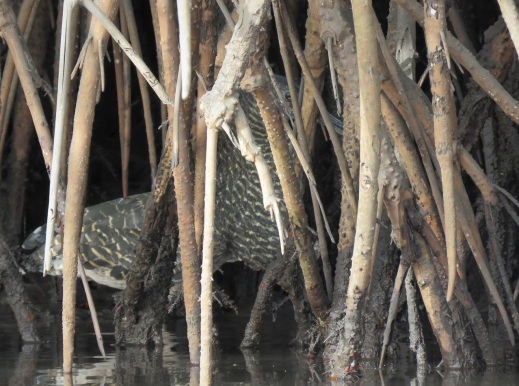
Our main target during a brief visit to the Saloum delta national park, just last week, was a rather unique bird that had so far eluded us: the enigmatic Tigriornis leucolopha. Its presence in the area has been known for a few years only, but it quickly became a classic target species for visiting birders – particularly those touring the country with the excellent Abdou “Carlos” Lo who is based at Toubacouta. But it’s one of those birds that requires a bit of planning combined with a decent dose of luck. It’s certainly not enough to just get on a pirogue into the mangrove forest where it lives: thanks to Abdou’s expert advice, we made sure to set off at low tide even if this meant going out in the mid-afternoon heat.
I’d always thought that the White-crested Tiger Heron (Onoré à huppe blanche) was more of a nocturnal or at best a crepuscular species, but that’s obviously not the case: when the tide is low, it will come out to the edge of the mangrove to fish, apparently at pretty much any time of the day. We were extremely lucky to actually witness this first-hand: after an unsuccessful attempt in one of the bolongs near the island of Sipo, our piroguier Abdoulaye eventually spotted a Tiger Heron, very much out in the open as we drifted past at fairly close range. It quickly entered the dense mangrove forest only to re-appear in a more concealed area a few meters away, carefully navigating the labyrinth of roots and tangles.
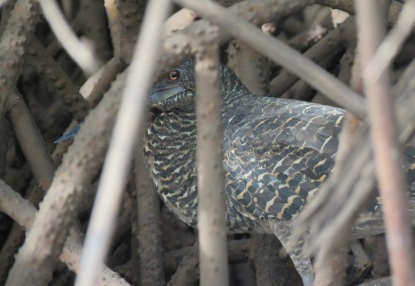
White-crested Tiger Heron / Onoré à huppe blanche, Sipo, 25.12.19 . Check out its amazing yellow-and-burgundy eye
As we were watching and photographing this dream bird, it caught a small fish, gobbled it down and quickly vanished back into the forest.
Note the rather cold colours and overall rather pale plumage of this individual, something that’s also visible in other pictures from the Saloum: possibly an adaptation to the mangrove environment here? Compare with the darker and more rufous birds found in e.g. Ghana and Gabon, for instance in the photo gallery of the Internet Bird Collection.
All in all, quite a surreal moment and a perfect Christmas present – Frédéric and I were of course hopeful we’d get a glimpse of this secretive heron, but certainly never thought we’d get such amazing views. It easily ranks in my Top 10 of Best African Birds Seen So Far, alongside the likes of Quail-Plover, Egyptian Plover, Crab Plover, Pel’s Fishing-Owl, Pennant-winged Nightjar, Böhm’s Spinetail, Little Brown Bustard, Wattled Crane and of course the most bizarre Grey-necked Picathartes (and Shoebill and Locustfinch and Spotted Creeper and… so on). Just like some of these species, the White-crested Tiger Heron – or White-crested Bittern as it is sometimes called – is the unique representative of its genus.
Here’s one more picture of this amazing bird, taken by Frédéric as we first spotted it – pretty cool, right?
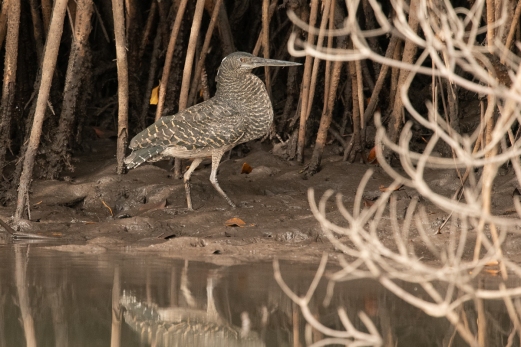
White-crested Tiger Heron / Onoré à huppe blanche (Frédéric Bacuez/Ornithondar)
Earlier that same day – much earlier actually, about 6.45 am to be precise! – we had already heard the rather ghost-like song that’s typical of the species, right from the small jetty at our campement villageois at Dassilame Serere. The song is not dissimilar to the Eurasian Bittern, a monotonous booming “whooooooom” uttered at a very low frequency, at 4-6 second intervals, which however got easily drowned in the dawn chorus of roosters, donkeys, dogs and goats of Dassilame… and which stopped abruptly just as daylight started to take over the night. The next morning I was better prepared and actually managed a few mediocre recordings when two distant birds were singing to each other deep in the mangrove, again pre-dawn and stopping before it properly got light. These turned out to be the first to be uploaded onto xeno-canto: check out the species page here (and make sure to turn up the volume to the max as the sound is quite subdued).
Tiger Bird habitat:
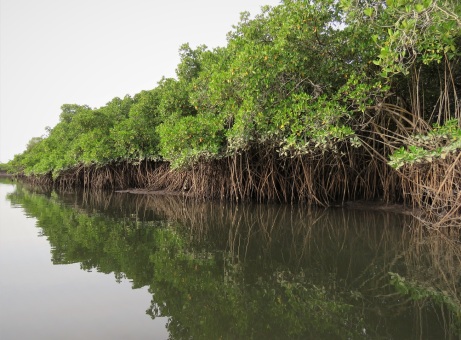
White-crested Tiger Heron / Onoré à huppe blanche (yes it’s in the picture… just impossible to see, even when you know where it is! When we first saw it, it was out on the tiny patch of mud to the right)
The Tiger Heron was initially thought to be restricted, in Senegal that is, to the Basse-Casamance region, where the first record is that of two nestlings collected and raised near the village of Mlomp (Oussouye) in 1979, followed by a few sightings in 1980-81 in the Parc National de Basse-Casamance and a nest found in Nov. 1980 north of Oussouye (A. Salla in Morel & Morel 1990); as far as we know, the next confirmed record was obtained in… 2017, at Egueye island, also near Oussouye, on January 1st, so almost 36 years later.
The first mention of the species in the Saloum delta is from 1980 by A. R. Dupuy (1981), while the next published record is from 2004 only – see comment by John Rose on this blog post [updated 4 Jan 2020] and the short paper by Rose et al. (2016). The next observation that I could find is from January 2007, of a bird photographed near Missirah by Stéphane Bocca. The fact that we heard two birds singing from Dassilame Serere, the records near Toubacouta and Sipo as well as the observation from Missirah all suggest that the Tigriornis is fairly well established here, and may well be widespread throughout the vast mangroves of the Saloum delta: targeted searches are likely to turn up more birds in other parts of the delta. The species is also present in mangroves along the Gambia river, where first discovered in 1996 (Kirtland & Rogers 1997). Casamance and especially the Saloum delta are actually right on the edge of the distribution range of the species, which extends from central Africa through the Congo-Guinean forest zone. In Senegal and Gambia, it primarily inhabits the vast mangrove forests, though it may also still occur in the swamp forest of the Basse-Casamance NP, i.e. in similar habitat to that occupied further south such as in Côte d’Ivoire and Ghana.
Other good birds seen during our boat trip included several majestic Goliath Herons, Palm-nut Vultures, a colour-ringed German Osprey (more on this later), a few Blue-breasted Kingfishers and Common Wattle-eyes (both heard only), as well as an unexpected Swamp Mongoose seen in full daylight (Héron goliath, Palmiste africain, Balbuzard, Martin-chasseur à poitrine bleue, Pririt à collier, Mangouste des marais).
During our stay in the Toubacouta area, we also visited the Sangako community forest, Sandicoly, and bush/farmland near Nema Ba: plenty of birds everywhere, though no real surprises here, except maybe for a fine pair of Bateleurs, a species that’s right on the edge of its regular range here. Other goodies for us northerners included Swallow-tailed Bee-eater, Grey-headed Bushshrike, White Helmetshrike, Bruce’s Green Pigeon, Four-banded Sandgrouse and many more of course (Guêpier à queue d’aronde, Gladiateur de Blanchot, Bagadais casqué, Colombar waalia, Ganga quadribande). Also a nice series of owls heard from our campsite: Greyish Eagle Owl, African Scops Owl, Pearl-spotted Owlet and Barn Owl! (Grand-duc du Sahel, Petit-duc africain, Chevêchette perlée, Effraie des clochers).
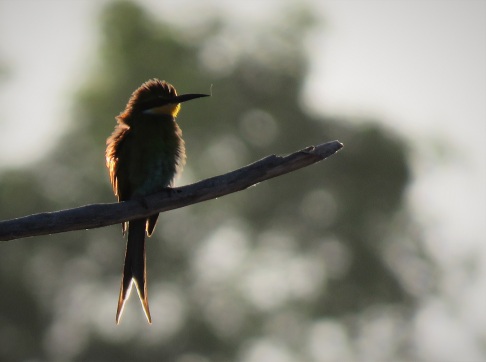
Swallow-tailed Bee-eater / Guêpier à queue d’aronde
With the addition of the Tiger Heron but also Ferruginous Duck (a pair on a small dam near Mbodiene, 24.12; Fuligule nyroca), my Senegal list now stands at 530 species: which one will be next?
Seawatching Ngor – October & November 2019
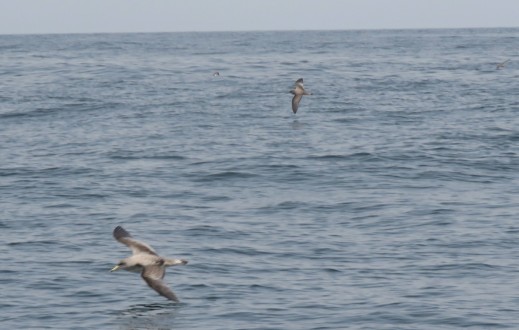
We’re entering the final stretch of this year’s seawatch season, but before we wrap things up in a few weeks, it’s time for a quick overview of October and November. As for August and September, below is a comparison of the 2019 counts with those from the previous two years. Even if observer effort and coverage were quite different in those three years, it’s clear that there are important variations from year to year, both in terms of phenology and in terms of abundance of many of the seabirds that migrate past the Dakar peninsula. Prevailing weather conditions, and in particular dominant wind direction (and wind force), of course have a strong influence on the intensity of visible seabird migration, though other factors are also at play for certain species. Annual variations in breeding success of skuas are well documented and probably explain some of the annual differences that we see here in Dakar.
This year’s coverage was again pretty good for October (28 sessions on 24 days, similar to Oct. 2017) but less so for November (15 sessions on 12 days), though we did manage to do longer counts during both months, especially in November. But let’s start with October:
Species |
2019 |
2018 |
2017 |
| Cory’s/Scopoli’s Shearwater |
86 |
0 |
232 |
| Sooty Shearwater |
631 |
1,035 |
2,534 |
| Manx Shearwater |
20 |
8 |
29 |
| Shearwater sp. |
24 |
4 |
22 |
| Wilson’s Storm-Petrel |
0 |
0 | 96 |
|
Northern Gannet |
3 | 2 |
1 |
| Brown Booby |
0 |
1 | 0 |
| Oystercatcher |
24 |
20 | 18 |
|
Common Ringed Plover |
2 | 0 |
5 |
|
Whimbrel |
32 | 4 |
8 |
| Bar-tailed Godwit |
8 |
0 | 10 |
| Turnstone |
6 |
0 | 0 |
| Ruff |
0 |
0 | 12 |
| Dunlin |
0 |
0 |
2 |
|
Sanderling |
16 |
6 |
0 |
| Little Stint |
6 |
0 | 0 |
|
Common Sandpiper |
4 | 0 |
0 |
|
Greenshank |
0 | 0 |
1 |
|
Common Redshank |
3 | 5 |
0 |
| Grey (Red) Phalarope |
12 |
0 | 78 |
|
Audouin’s Gull |
77 | 21 |
55 |
| Lesser Black-backed Gull |
3 |
18 | 2 |
| Yellow-legged Gull |
1 |
0 |
0 |
|
Large gull sp. |
8 | 0 |
7 |
| Slender-billed Gull |
6 |
1 | 4 |
|
Grey-headed Gull |
2 | 0 |
0 |
| Sabine’s Gull |
1,081 |
178 | 2,970 |
|
Arctic/Common Tern |
3,768 | 1,094 |
4,296 |
| Roseate Tern |
6 |
14 | 54 |
| Little Tern |
65 |
7 |
78 |
|
Sandwich Tern |
2,479 |
905 | 1,313 |
|
Lesser Crested Tern |
299 | 113 |
150 |
| African Royal Tern |
457 |
198 | 57 |
| Caspian Tern |
22 |
20 |
9 |
|
Black Tern |
1,059 | 333 |
2,735 |
| Whiskered Tern |
1 |
0 | 1 |
|
Bridled Tern |
1 | 0 |
0 |
| Bridled/Sooty Tern |
1 |
0 | 0 |
|
Great/South Polar Skua |
60 | 11 |
66 |
| Pomarine Skua |
763 |
85 | 1436 |
|
Arctic Skua |
486 | 198 |
339 |
| Long-tailed Skua |
47 |
21 | 32 |
|
Skua sp. |
476 | 182 |
1138 |
|
Total birds |
12,045 | 4,484 | 17,880 |
|
Number of days |
24 |
10 |
26 |
|
Number of hours |
37h30′ | 19h00′ |
28h20′ |
October was relatively quiet compared to previous years, mostly because conditions were not so favourable during the last 10 days of the month, hitting an absolute low on Oct. 31st when only 68 birds were counted in one hour… With hardly any wind, far fewer Sooty Shearwaters and Pomarine Skuas than usual were noted (Puffin fuligineux, Labbe pomarin). Most terns however were more numerous, possibly due to a later passage than in previous years, particularly for African Royal, Lesser Crested and Sandwich Terns (Sternes royales, voyageuses, caugeks). With just over 1,000 birds, the passage of Sabine’s Gull was fairly average though still very enjoyable on two days: 220 in 2h45’ on Oct. 12, and 315 in 3h20’ on Oct. 17 (Mouette de Sabine). Among the rarer species, an ad. Bridled Tern was seen on Oct. 12 (+ a distant Bridled or Sooty on Oct. 8; Sterne bridée).
November was a different story: with a fairly similar number of hours spent counting birds from the Calao terrace, almost double the number of birds were counted than in 2017. A much stronger passage was noted for many species: Cory’s/Scopoli’s Shearwaters (56,438 birds counted: almost twice the 2017 number and triple that of 2018!), Great Shearwaters, Sooty Shearwaters, Northern Gannets, and Pomarine & Arctic Skuas (Puffin cendré / de Scopoli, Puffin majeur, fuligineux, Fou de Bassan, Labbes pomarins et arctiques). Because we were present on less days but spent more time per session, it’s hard to compare with previous years, though it’s clear that at least some of these species were more numerous, such as the Gannets that passed through en masse from the 10th onward (max. 1,223 birds in 90’ on Nov. 20!), which is far earlier than in previous years when peaks were noted from the end of the month and in December. The higher number of skuas and Sooty Shearwaters are also at least in part explained by the later passage, properly starting only around November 10th rather than in the last week of October. Only one Long-tailed Skua was identified during this period, at the very start of the month, bringing this season’s total to 489 birds.
The peak passage of Cory’s/Scopoli’s Shearwaters took place during Nov. 10-16, with up to 4,020 birds passing through per hour during the morning of the 10th. While slightly less intense in previous years, the highly concentrated passage took place almost exactly during the same period. It’s really remarkable how this species pair is completely absent up to the very last week of October: the first 45 birds were seen on Oct. 28th with just a handful in subsequent days, then 638 in 1h15’ on Nov. 4th and 215 in 1h45’ the following day, then literally exploding just a few days later (unfortunately no observations were made during Nov. 6-9). Our counters nearly overheated, thumbs hurting! In comparison, the migration pattern of Sooty Shearwater for instance is very different, showing a very long and diffuse migration season (end August – mid December) without a clearly defined peak.
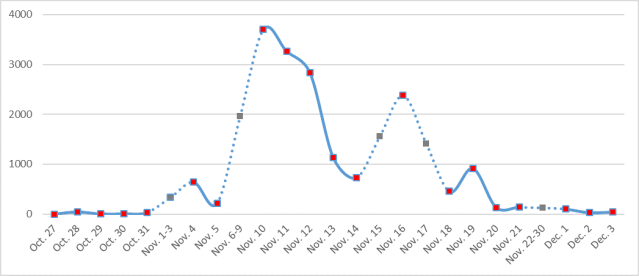
Daily average number of Cory’s & Scopoli’s Shearwater per hour (2019). The dotted lines and grey markers indicate extrapolated data; red markers are based on actual counts
Besides this really impressive flow of the shearwaters, the highlights in November were our first (ever!) Leach’s Storm Petrels (Océanite cul-blanc), the good number of Great Shearwaters of course – confirming that quite a few pass through Senegalese waters at this time of the year – a fine Balearic Shearwater (Nov. 18; Puffin des Baléares), and an imm. Red-footed Booby seen twice flying past the Calao (Fou à pieds rouges). Another big surprise and clearly one of my highlights was a huge Killer Whale (Orque) swimming past at mid-range, apparently heading SW – not my first here at Ngor, but this one was really impressive, nicely showing its massive dorsal fin.
November summary:
Species |
2019 |
2018 |
2017 |
| Cory’s/Scopoli’s Shearwater | 56,438 | 18,593 | 30,836 |
| Great Shearwater | 125 | 32 | 0 |
| Sooty Shearwater | 1,174 | 573 | 526 |
| Balearic Shearwater | 1 | 0 | 0 |
| Manx Shearwater | 5 | 4 | 1 |
| Shearwater sp. | 16 | 31 | 2 |
| European Storm-Petrel | 0 | 0 | 1 |
| Leach’s Storm-Petrel | 3 | 0 | 0 |
| Storm-Petrel sp. | 10 | 0 | 0 |
| Northern Gannet | 3,896 | 1,239 | 60 |
| Brown Booby | 0 | 2 | 3 |
| Red-footed Booby | 1 | 1 | 0 |
| Oystercatcher | 0 | 0 | 2 |
| Common Ringed Plover | 0 | 0 | 1 |
| Grey Plover | 1 | 0 | 0 |
| Whimbrel | 9 | 4 | 0 |
| Bar-tailed Godwit | 5 | 0 | 0 |
| Grey Phalarope | 1 | 0 | 26 |
| Audouin’s Gull | 255 | 514 | 40 |
| Lesser Black-backed Gull | 37 | 2 | 17 |
| Yellow-legged Gull | 3 | 0 | 0 |
| Large gull sp. | 47 | 0 | 5 |
| Slender-billed Gull | 10 | 1 | 1 |
| Sabine’s Gull | 144 | 13 | 226 |
| Arctic/Common Tern | 1,272 | 836 | 764 |
| Little Tern | 14 | 14 | 1 |
| Sandwich Tern | 313 | 105 | 178 |
| Lesser Crested Tern | 2 | 7 | 18 |
| African Royal Tern | 19 | 9 | 2 |
| Caspian Tern | 3 | 1 | 2 |
| Black Tern | 29 | 3 | 321 |
| Catharacta Skua sp. | 32 | 23 | 5 |
| Pomarine Skua | 2,917 | 2,144 | 1,819 |
| Arctic Skua | 149 | 66 | 76 |
| Long-tailed Skua | 1 | 1 | 9 |
| Skua sp. | 149 | 60 | 313 |
| Total birds | 63,833 | 21,984 | 33,033 |
| Total days | 12 | 21 | 20 |
| Number of hours | 33h | 30h30′ | 28h |
November 11th clearly was one of our most memorable Seawatch sessions ever: in just 3 hours, we counted an impressive 12,492 birds belonging to 23 species, a remarkable diversity at this time of the year: check out our eBird checklist here!
Once again, needless to say that Dakar clearly ranks as one of the top seawatch spots in the world!
Seawatching Ngor – September 2019
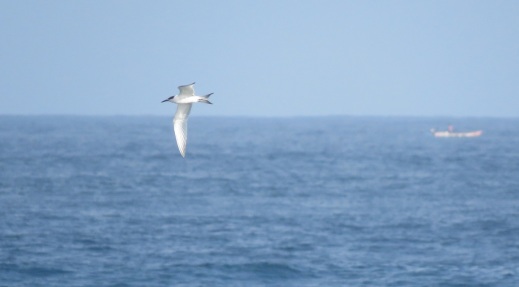
I count myself extremely lucky to live just a few minutes away from what must surely be one of the best seawatch sites in the world. What other capital can compete with Dakar on that front? It does make it hard not to go out there every day, especially at this time of the year when so many migrants can be seen from this privileged spot. And I’m fortunate to have a very flexible work schedule that allows me to spend an hour or so counting seabirds before heading to the office! I’m obviously spending too much time at the Calao at the moment… but then again it’s always better being out birding in the field than sitting behind a desk (especially when The Field is a comfortable terrace, sat under a sun umbrella with a cup of decent coffee).
Anyway, time for the September numbers:
- 25 days
- 38 hours
- 20,109 birds belonging to 36 species counted (total so far: 27,303 birds!)
This is a much better coverage than in previous years, and as a result the number of birds counted is higher for most species; Lesser Crested Tern is the main exception due to a later than usual passage, which only started properly at the very end of the month, picking up rapidly during the first few days of October (Sterne voyageuse).
As usual, here some of the highlights: good numbers of Manx Shearwater (also two possible Balearics… unfortunately too distant and poorly seen), and several Macaronesian Shearwaters including at least one that seemed right for Boyd’s (Puffins des Anglais et de Macaronésie). Sooty Shearwater passage was clearly more intense, or at least more visible, than last year, probably because of more favourable winds (Puffin fuligineux).
Numerous terns were counted of course, with the four most common species – Common & Arctic, Sandwich, Black Terns – accounting for nearly 90% of the twenty thousand birds counted this month (Sternes pierregarin et arctique, caugeks, Guifette noire). Roseates continued to pass through almost daily, up to 12 BPH (that’s birds per hour!), and so did Little Tern: with 304 birds in September, far more were seen than in previous years (and the passage continues: on 5.10 a total of 31 birds were seen in one hour, including a flock of 22) (Sternes de Dougall et naine). A Bridled Tern on the 4th is so far the only one of the season (Sterne bridée).
September is also peak month for Sandwich Tern (Sterne caugek), which passes through daily in double or even triple digits (that’s BPH). The peak at the end of the month is clearly visible on this chart combining 2017 and 2018 data:
Now for some slightly more advanced data viz’ fun: I tried to find a clever way of visualising the intensity of bird migration at Ngor alongside wind speed and wind direction. The chart below shows average “BPH” per day as histograms (primary axis: number of birds) and wind speed as the dotted line (secondary axis: knots), while the colour represents the wind direction: dark green for WNW to N winds, pale green for SW to W winds, and orange for SSW to ENE. One would expect the highest number of birds during the favourable winds, i.e. higher wind speed from a WNW to N direction, and less so on days with little wind and/or with winds coming from the “wrong” side. That does seem to be the case on most days, but not always… though in general it’s fair to say that days with stronger NW winds usually see the highest number of birds, and also a higher diversity of species. Shearwaters, skuas, Sabine’s Gulls and most terns are largely influenced by these conditions, which can rapidly change from day to day or even within the same day. A good site to check out wind forecasts is Windguru.
Arctic Skuas continued to pass through on a daily basis, and Long-tailed Skuas were seen on 13 dates, mainly at the start and at the end of the month, with a max. of 61 birds in 2h15′ on the 4th (Labbes arctique et à longue queue). The four Catharacta skuas were seen in the last week of the month but as usual could not be identified down to species level (Great or South Polar Skua, Grand Labbe/Labbe de McCormick).
A usual, waders were fairly well represented this month: Whimbrel and Oystercatcher remain the most frequent migrants and thanks to the regular rains this autumn there has been a good diversity of waders in general, including my first Grey Plovers here and regular sightings of migrating Turnstones (Courlis corlieu, Huîtrier pie, Pluvier argenté, Tournepierre). Red Phalaropes were seen on five occasions in relatively modest numbers (Phalarope à bec large).
Table with September totals for 2019, 2018 and 2017:
Species |
2019 |
2018 |
2017 |
| Cory’s/Scopoli’s Shearwater | 2 | 0 | 0 |
| Sooty Shearwater | 271 | 87 | 393 |
| Balearic Shearwater | 0 | 0 | 1 |
| Manx Shearwater | 98 | 6 | 60 |
| Boyd’s/Barolo Shearwater | 9 | 16 | 1 |
| Shearwater sp. | 51 | 22 | 34 |
| Storm-Petrel sp. | 1 | 0 | 0 |
| Northern Gannet | 0 | 1 | 1 |
| Brown Booby | 0 | 4 | 3 |
| Oystercatcher | 51 | 20 | 16 |
| Whimbrel | 211 | 75 | 78 |
| Eurasian Curlew | 0 | 0 | 2 |
| Bar-tailed Godwit | 4 | 1 | 8 |
| Grey Plover | 2 | 0 | 0 |
| Common Ringed Plover | 0 | 2 | 0 |
| Turnstone | 33 | 2 | 0 |
| Dunlin | 0 | 0 | 40 |
| Sanderling | 12 | 0 | 25 |
| Little Stint | 1 | 0 | 0 |
| Common Sandpiper | 1 | 0 | 0 |
| Greenshank | 1 | 0 | 0 |
| Common Redshank | 3 | 1 | 1 |
| Grey (Red) Phalarope | 163 | 133 | 1 |
| Audouin’s Gull | 21 | 1 | 3 |
| Lesser Black-backed Gull | 1 | 15 | 1 |
| Kelp Gull | 1 | 0 | 0 |
| Large gull sp. | 1 | 5 | 0 |
| Slender-billed Gull | 6 | 1 | 1 |
| Grey-headed Gull | 0 | 1 | 2 |
| Sabine’s Gull | 95 | 43 | 123 |
| Arctic/Common Tern | 11,161 | 4,100 | 4,500 |
| Roseate Tern | 144 | 89 | 35 |
| Little Tern | 304 | 57 | 76 |
| Sandwich Tern | 2,425 | 2,080 | 1,928 |
| Lesser Crested Tern | 61 | 147 | 95 |
| African Royal Tern | 295 | 305 | 219 |
| Caspian Tern | 10 | 13 | 19 |
| Black Tern | 3,870 | 2,187 | 2,342 |
| Sooty Tern | 0 | 1 | 0 |
| Bridled Tern | 1 | 0 | 0 |
| Great/South Polar Skua | 4 | 1 | 2 |
| Pomarine Skua | 13 | 5 | 35 |
| Arctic Skua | 400 | 172 | 142 |
| Long-tailed Skua | 215 | 265 | 59 |
| Skua sp. | 167 | 64 | 226 |
| Total birds | 20,109 | 9,922 | 10,472 |
| Number of days | 25 | 17 | 15 |
| Number of hours | 38h35′ | 24h50′ | 20h30′ |
In addition to the seabirds, as usual a few other species were noted on active migration: a Purple Heron on 10.9 and more surprisingly two Squacco Herons the next day coming from out at sea. Common Swifts were spotted on at least three occasions (max. 66 on 11.09, migrating low over the ocean), while a Hoopoe was seen on 8.9 and a Sand Martin on 12.9 (Heron pourpré, Crabier, Martinet noir, Huppe fasciée, Hirondelle de rivage). What appeared to be a juv. Barbary Falcon was seen several times from 4 – 12 Sept., with a Peregrine also here on 9th (Faucons de Barbarie et Pèlerin). This provided for some action as both birds were regularly seen hunting pigeons and other birds; on the 6th it was a juv. Common Cuckoo (or at least I assumed it to be this species and not African Cuckoo) which was seen coming on land from Ngor island or islet, chased by the Barbary Falcon only to disappear into the Calao gardens and never to be found again… (Coucou gris).
That’s all for now – let’s see what October brings (Pomarine Skuas! Sooty Shearwaters! Sabine’s Gulls!). Conditions are expected to be good in the next few days.
The August report can be found in this post.

